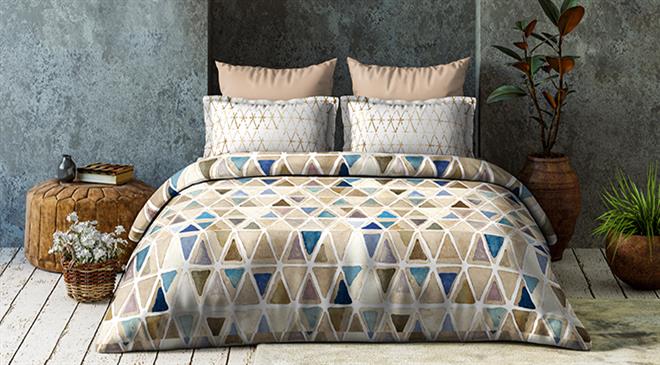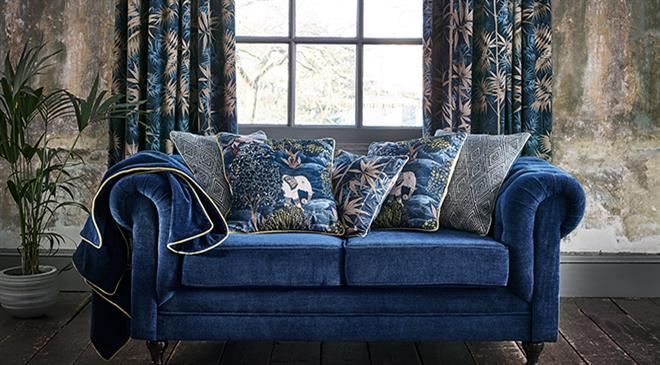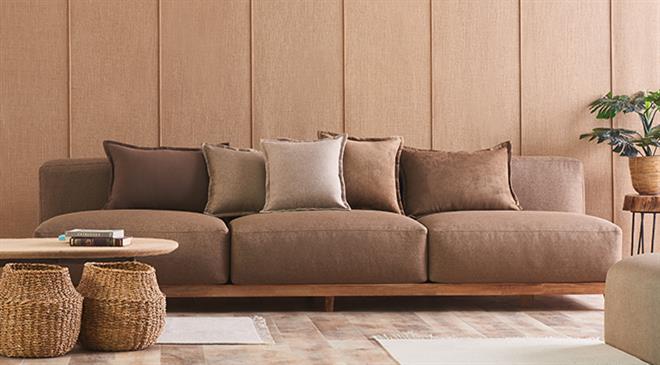Consumers have increased their spend on home than normal times
D'Decor is the largest maker of woven upholstery and curtain fabrics in the world. The company has 5 state of the art plants in Tarapur, India where every year 44 million metres of fabric are produced. The company also has the distinction of having the country's first robotic warehouse. Fibre2fashion interviews Ajay Arora, MD of D'Decor, to gather details about the home furnishing industry, the factors affecting its growth and major challenges.
How has the Corona pandemic impacted the home furnishing industry in India?
There are 2 different segments which are impacted differently.
1) The export segment is impacted very positively. Anybody who is exporting home textiles from India, is seeing an increased demand from the western world and that is stemming from the fact that people are at home and Western government has put a lot of money back into the economy and within that a good share of money is going towards home improvements since people are mostly working from home or staying at home.
As far as the domestic segment is concerned, it has been deeply impacted in 2 different ways:
Phase 1 - Everything was locked, you were not able to produce or sell depending whether you are a retailer or a manufacturer. You were at zero. You were not receiving any government help. You were not allowed to have any flexibility on your fixed cost. So, it was a sudden and significant impact on the financials.
Phase 2 - The markets are coming back to normal as the economy has opened up. In India we see home is a priority in expenditure allocation. So, there isn't a disastrous drop in demand. However, there is tremendous challenge coming from the consumers as they don't have the confidence, virus fear is very real, so consumption at retail is very restricted. The digital channel is compensating for some part of the drop and overall, I would say we are still in recovery mode as we speak now and still domestic market is below last year's numbers for most of the people, parts of the value chain and brands.
What is your export ratio compared to internal consumption within India?
We have a 60-40 ratio. Export is 60, domestic is 40.
What percentage of your sales is through brick & mortar and what through e-marketplace?
E-commerce is less than 10 per cent, but it is growing especially with the Covid impact. 90 per cent sales is through brick and mortar.
Has work resumed in your workshop/ factory? What percentage of your workers have resumed/quit?
Most of our workers are from UP, Bihar (migrant workers). All of them didn't go back. Out of my entire workforce, we are at 15 per cent less than full strength. We are in communication with most of these workers and they want to come back. They have difficulties in making their way back to the plant as they have gone to their hometowns and some transportation and lockdown issues are still there. So that's the status as on today. But the factories had resumed production in the first week of May itself.
How have consumer preferences changed in the current scenario?
Consumers have increased their spend on the home than normal times. There are lower footfalls at the various sale points, but the conversion percentage is very high. So there are serious buyers only. Based on their preference in terms of what they are buying, one striking change we can see is higher consumption on bedding and towels compared to some other categories in the home like curtain, upholstery, rugs and blinds. So, the allocation is more on bedding and towels given the importance of health, hygiene, sanitisation, etc. The frequently used items are being refreshed. In terms of aesthetics, there is no significant change due to the pandemic. There is a scope and desire for anti-bacterial and anti-viral products.

What are the major challenges facing this industry? Where should the government pitch in?
I don't think we need any more help from the government. We are a strong country with lots of positives in the textiles space: raw material availability, skill sets, heritage, ability to speak English - the list is too long. There is a large domestic market and we have the ability to do so much with the talented, educated Indian workforce who are available at a good value in dollar terms. There is nothing specifically needed.
If the government can create long term stable policies for the textile industry, that would suffice. The government has already done a lot. So, I don't subscribe to the view that we need any crutches.

Which are the factors that will fuel growth for the home furnishing industry going forward?
The biggest factor on the domestic market front is - our population demography is such that homes are increasing, number of nuclear families is increasing, younger people are getting married and starting their own family. There is a true demand and need for this demography to own a house.
The second factor that will pull the demand is - Indian companies are able to use better business models to penetrate the world market. The whole e-commerce and the digital piece is a big opportunity for the Indian companies. India is good in IT and textiles, and should be able to combine both of these and penetrate with better price points and closer to the consumer.
The third factor would be global trade agreement which I think will be favourable to India. There is a high possibility of India and US signing a favourable trade agreement and there is also a high possibility of India and UK doing it as UK is coming out of the EU. So, that would allow us to have equal advantages what the other players have, whether it is a Bangladesh or Pakistan.
The fourth factor is that the basic growth is there in the economy. Now the emphasis is on home. The whole world has got the wakeup call that home is a very important place and after the Covid experience, people are going to prioritise their home more.
Based on consumer preferences, how is your business going to get altered?
We are looking at 3 changes. One is the importance of digital - the first change under digital is that there is a need for digital availability of products where the consumer doesn't want to access it physically. The second change under digital is, you need to use the digital channel to show how the product will be applied or whether it is available.
Beyond the digital aspect, the second aspect is definitely the need for our product to be far more sustainable, far more functional on aspects of health and hygiene. So functionality in home textiles is becoming more important.
The third change we are seeing is that the customers want a simpler home décor journey. Current customer journey is quite complicated. There are 2-3 steps involved since most of the furnishings in India are custom made. Now there is a slight shift towards readymades.
How big is the home fabric and furnishing industry in India? What is D'Decor's share in it?
The industry has different product categories. Curtain and Upholstery is close to 4000 crores and D'Decor has around 20-25 per cent market share. The bedding business is much larger, and D'Decor is among the important 2-3 brands. But the share is still very small because un-organised sector in bedding is very large.
You recently partnered with Swiss textile innovator HeiQ to launch antiviral and air purifying range of furnishing fabrics. What are the unique characteristics of such fabric?
As we are trying to save ourselves from getting infected, one of the frequently contacted surfaces is the home textiles. You just cannot avoid physical contact with upholstery on your chair or sofa, your bedding, etc. The antiviral, which is a topical finish, we are using this chemical in partnership with the Swiss company HeiQ. They have developed a product which is tested and is proven to eliminate any virus which comes in contact with any fabric within a minute and that efficiency keeps the next person who comes in contact with that fabric, completely safe.
What do the slogans 'Vocal for Local' and 'Make in India' mean to you? How are you adopting these trends within your products?
There is a need for India to grow its own economy and give employment to its people. So, this is 'Vocal for Local' and 'Make in India', the government's message. At D'Decor, this is a message that we have adopted from Day 1. Everything we do is in India; all our manufacturing is in India. 90 per cent of the products we sell to any part of the world come from our own manufacturing. We want to improve this by taking it up from 90 to 100 per cent.
We need to take the larger message - to create growth and employment and contribute to the Indian economy more.

Which are the major brands and retailers you have tie-ups with?
Specialty Stores is one of our channels. We are present at 2000 sales points in more than 150 cities in India. All the premier outlets are our partners. In the Online channel, we are available at Myntra, Amazon and Flipkart - that is the second channel and ofcourse on our own website. The third channel is large format stores - our packaged products are sold at Lifestyle, Shopper's Stop and Hometown.
Which bracket do your customers fall into? Are your products meant for the rich upper class lot or are they uniformly divided across segments?
We are catering to a very wide price range. The brand is more towards the premium end. We can say we are catering to the affordable luxury segment, given the fact that frequency of change in home curtain, upholstery is less, upholstery change is quite infrequent. The spend that D'Decor warrants for home furnishing of a 2-bedroom flat is very much within the reach of millions of homes of India.

What are the short and long-term sustainability goals set at D'Decor?
Sustainability is something we have always been sensitive to. Today, 70 per cent of the water that we use in our manufacturing is recycled. We would like to increase it to 90 per cent, that is one goal. Currently 12 per cent of the electrical energy is coming from the renewable source - solar. All the roofs at our plants are covered with solar panels and the goal would be to double these numbers. The third aspect is the elimination of any harmful substance. The fourth is to give big priority to fibres that are sustainable. D'Decor is beginning to increase the offering and the production being done from these fibres, which are recycled polyester made from plastic bottles. We have a serious effort underway to eliminate a good quantum of plastic waste by using recycled polyester fibre. Then we want to encourage use of organic cotton, which is again sustainable. With respect to the chemicals that we use, we are compliant with a number of environment friendly regulations - REACH, Oeko-Tex etc. We want to eliminate certain harmful compounds which are bad for the environment which are put in finishing chemicals. The finishing chemicals do attribute some cleaning properties e.g easy to clean etc. We are collaborating with our chemical suppliers to achieve the same properties without any carbon or CO inside.
We are working with Reliance and RSWM to source sustainable fibres. These companies have installed capacities which specifically convert plastic to polyester.
We are also looking at packaging on how we can make it sustainable. These are some of the sincere efforts we are pursuing on the sustainability front..
What are your expansion plans for the next 5 years?
We are a company that would continue to maintain a steady growth rate of 15-20 per cent every year based on what is happening in all our markets. We hope the brand D'Decor would go abroad in the next 5 years and expand its recognition with international consumers. (PC)
Which are your highest selling products? Which others are catching up?
We sell different construction and varieties - there are some 12,000 options that we offer. Since India is a diverse country, the price points, looks, end uses, performance factors - each product has its own merit combination. There is no particular one product that is driving large part of our sales. Every year we rollout series of new collections to keep the fashion and other aspects catered to.
Largest part of our sales is coming from curtains followed by upholstery. Opportunities in bedding, wallpaper and rugs are large.
Which are your major markets worldwide? Which new markets you want to enter?
US and Europe are our major markets. We are focused on expanding our business in India, US, Europe and the Middle East and few other key markets like Australia, Japan and South Africa. These are the markets which have per capita spend on home. But we do not want to go into more and more countries. We are building a better distribution in the countries in which we already exist by customising products, understanding needs better, and getting more market share.





